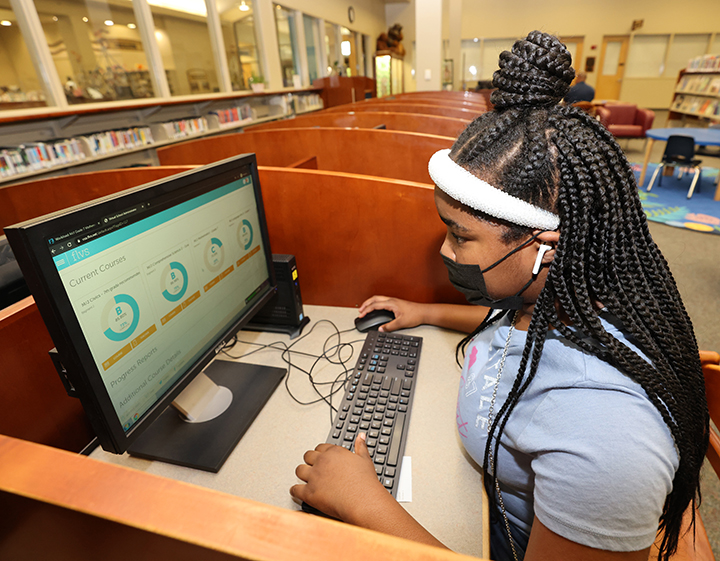Virtual school growth spurs debate on funding

Alayjah Burgess, 12, checks on her school courses in the Virtual Classroom on a computer at the Marion County Public Library Headquarters on East Silver Springs Boulevard in Ocala, Fla. on Wednesday, April 21, 2021. [Bruce Ackerman/Ocala Gazette] 2021.

A student checks on her school courses in the Virtual Classroom on a computer at the Marion County Public Library Headquarters on East Silver Springs Boulevard in Ocala, on April 21, in this file photo. [Bruce Ackerman/Ocala Gazette]
The COVID-19 pandemic prompted skyrocketing student enrollment in virtual education, putting a spotlight on competition among Florida providers — and igniting a debate about whether lawmakers should tweak the way public schools are funded as more students take classes online.
“It is a fair question that a 45-year-old funding formula that was designed in a world of zero school choice of any kind, not choice schools, not charter schools, not virtual schools, not private schools, it was ‘you will go to your neighborhood school and like it,’ does that funding formula still work in a world where more and more families are availing themselves of choice? I would argue that it doesn’t,” House PreK-12 AppropriationsChairman Randy Fine told The News Service of Florida in an interview Thursday.
Florida students have several virtual-school options. The state offers full- or part-time instruction through Florida Virtual School, the oldest and largest online provider.
Students also can enroll in virtual charter schools, and school districts can contract to use the Florida Virtual School model, create their own virtual schools or contract with private virtual providers.
Because virtual education has no defined borders, families can choose to enroll their students in virtual schools anywhere in the state.
But during the legislative session that ended in April, lawmakers put a cap on how many out-of-district students a county school district’s virtual program can accept.
Under the change, the number of out-of-county students enrolled in a district’s virtual program cannot be more than 50 percent of the number of enrolled virtual students who live in the district.
The new policy applies to contracts signed after June 30 and was not applied retroactively.
Last week, Fine raised a concern to his House panel about students enrolling in district virtual schools outside of the counties where they live. Fine, for example, said 96 percent of students enrolled in the Hendry County district’s virtual school last school year were from different counties.
The roughly 5,700 students who attended Hendry County’s virtual school made up about 42 percent of the district’s total student enrollment.
“School districts are created for the benefit of the families and children living in that district. That’s their primary beneficiary. And when 40 percent of your students aren’t even from your school district anymore, and that could easily exceed 50 percent, are you actually working for the benefit of the families that you serve?” Fine said.
Fine said he called attention to the situation involving Hendry County to illustrate “problems” with the Florida Education Finance Program, or FEFP, which is the main funding system for public schools.
“Students are funded by state and local funds. Every one of those (virtual) students that’s coming to Hendry County from another county is bringing their state funds with them, but they’re not bringing their local funds with them. So, Hendry local funds are having to be spent over many more students than there are actually families being taxed in Hendry County,” Fine said.
Fine said looking at the FEFP and how it funds virtual schools will be a focus during the 2022 legislative session, which starts Jan. 11. But he said “what we’re going to do about it remains to be seen.”
In the meantime, he characterized his concerns with virtual school funding as being about “laundering” students from across the state.
“Should virtual schools be run through school districts where students have to be laundered? Or should this be centralized and done on a statewide level?” Fine said, floating the idea that all virtual school options should be “run centrally” and accessed on a statewide platform like Florida Virtual School.
Jim Horne, a former state education commissioner and state senator, said he agrees with Fine that school funding might need to be modernized to account for virtual education. But he pushed back on Fine’s framing that districts like Hendry are “laundering” students through virtual schools.
“The waters get a little bit muddy when you get into virtual, because virtual knows no boundaries. That’s the beauty of virtual education, you do not have jurisdictional lines drawn around a mythical county line,” said Horne, a lobbyist whose clients include Stride, Inc., a private virtual instruction provider.
Horne recalled watching the advent of virtual education in the state and the growth of Florida Virtual School through the early 2000s. Over the next two decades, lawmakers opened the door for increased competition through allowing other providers to enter the market.
“Quite frankly, each and every one made everyone better,” Horne said of virtual-school providers that set up shop in Florida.
Horne defended Hendry County’s virtual school, arguing that the district is doing what past legislatures encouraged: competing.
“Hendry stepped up in a big way and offered their little program statewide, and they had huge success. It feels like in some ways they’re being punished or being misaligned with what their motivations were. We heard comments that they’re laundering students. If meeting Florida parents’ needs is laundering students, then they are laundering students, but they’re doing what everybody asked all of our leaders to do,” Horne said.
Horne, who is a certified public accountant, said he understands that a rapid enrollment increase in a district’s virtual program would give pause to lawmakers who craft the state budget. But he doesn’t agree with capping out-of-county students in districts’ virtual schools.
“This is probably the first major reversal of education policy in a very long time. Generally we keep moving forward, taking quantum leaps, particularly with private vouchers. This is the first time that I can remember, of a major step back,” he said.
While lawmakers are poised to look at funding and enrollment in county virtual schools, Florida Virtual School has launched a program to expand beyond state lines and internationally.
Florida Virtual School this month launched a program called FlexPoint Education Cloud, which allows schools and districts from other states and elsewhere in the world to contract with the Florida-based provider for its online curriculum.
“Soon after I got here in 2019, we started to discuss the option of having an outward-facing brand for outside of Florida. And the pandemic kind of made it all coalesce, so the idea at the time was to finally get it done,” Florida Virtual School President and CEO Louis Algaze told the News Service this week.
Algaze said schools in states like Alaska contracted with the virtual school for curriculum and training for teachers. With the revenue generated by those contracts, Algaze said Florida Virtual School can improve its services.
“We generate revenues outside of Florida, we bring it back into Florida, and we use it to improve our curriculum, to update our curriculum,” Algaze said.





